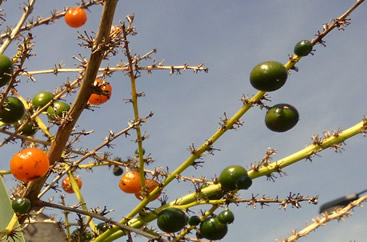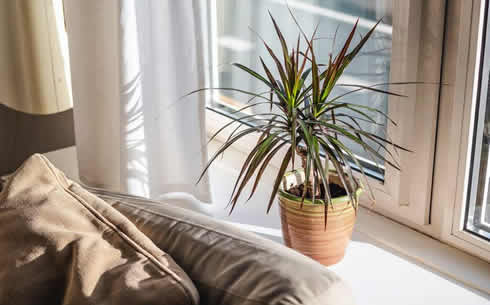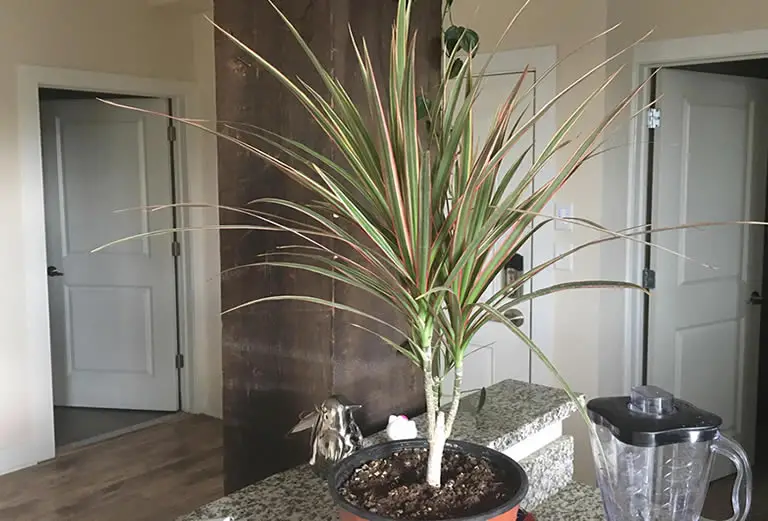The dragon tree is a tropical tree that is commonly grown indoors all across the country. As an easy-care succulent, the dragon tree has become very popular as a houseplant but if you have curious kids at home, who may nibble of the foliage or berries, you will want to know if this plant is poisonous.
Table of Contents
What is the dragon tree?
Before I address the question of toxicity with the dragon tree I must first identify what the dragon is.
This is purely because more than one plant is referred to by the common title dragon tree and therefore it is important you know if your particular dragon tree is poisonous.
So which plants are commonly called the dragon tree?
There are two plants that are commonly referred to as The Dragon Tree. Both are members of the dracaena plant family.
Dracaena Marginata is a dracaena succulent tree that is most commonly called the dragon tree but the Dracaena Cinnabari (also known as Dracaena Draco & Dragon Blood Tree) is also often referred to as the dragon tree.
When most people talk about a dragon tree they are referring to the more commonly grown Dracaena Marginata.
This tropical succulent tree is native to Madagascar and Mauritius.
The dracaena marginata has other common names that include Madagascar dragon tree, dracaena palm (though it is not a palm tree) and dracaena dragon tree.

However the dracaena marginata is not the only succulent tree to be called a dragon tree.
Dracaena Cinnabari is another species of dracaena that is commonly referred to as the dragon tree.
This tropical succulent tree grows natively in the Socotra archipelago part of Yemen which is located in the Arabian Sea.
The dracaena cinnabari is also called dracaena draco, the Socotra dragon tree and is also commonly known as the dragon blood tree.
As you can see both these dragon trees are members of the dracaena plant family.
The name dracaena is actually derived from a Romanized version of an ancient Greek word, “δράκαινα” (pronounced drack-in-a) , meaning “ogress” or what we would refer to as “dragon”.
In this image you can clearly see that a dracaena marginata tree that has no foliage looks very much like a dragon claw with nails included.
Although not all dracaena resemble a part of a dragon, take the dracaena lemon lime for example, the entire 120 species of plants in this botanical family were given the dracaena name.
For more information on other dracaena plants read our article What Are Dracaena Plants.
So to reiterate … the two species of succulent tree known commonly as The Dragon Tree are:
- The Dracaena Marginata.
- The Dracaena Cinnabari.
Let’s now take a look at whether these dragon trees are poisonous to humans.
Are the Dracaena Marginata & Dracaena Cinnabari dragon trees dangerous?
The dragon tree is, arguably, the most popular dracaena plant grown in homes.
So it should come as no surprise that I am often asked if this specific dracaena is poisonous to humans.
The Dracaena Dragon Tree, Dracaena Marginata, also known as the Dracaena Palm and Madagascar Dragon Tree, is non-toxic to humans.
This means it is safe to grow around children.
The Dracaena Draco, Dracaena Cinnabari, which is also known as the Socotra dragon tree and Dragon Blood Tree is also non-poisonous to humans.
Although it is extremely unlikely that an adult will chomp down on the foliage of a dragon tree it is very common for curious children to nibble on leaves, blooms and berries that grow on houseplants or that are within reach on garden plants.
The good news is that no species of dracaena is poisonous to humans.
All types of dracaena plants are non-toxic to humans and this therefore includes both dracaena dragon tree types.
This means any dracaena dragon tree, whether it be dracaena marginata or dracaena cinnabari, grown indoors or outdoors is not poisonous to humans.
But be aware that, if you have kids that strip your plant bare of its foliage you will have to wait a long time to regrow the leaves as dracaena is a slow grower.
However, if you own pets then you must read our article is dracaena poisonous so you can identify if your particular species of pet is at risk.
The potential dangers of dragon tree berries
Although the foliage and bark of a dragon tree is non-toxic to humans what about the berries?
And just as the foliage and bark is poisonous to certain animals does this mean the berries are poisonous to them as well?

The berries of a dragon tree are not poisonous to humans but are poisonous to certain animals.
Cats, dogs and horses are most at risk from eating dragon tree berries as ingestion will cause vomiting, severe loss of appetite, hyper-salivation, lethargy and could even be fatal.
An animal displaying any of these symptoms needs immediate veterinary care.
Dracaena houseplants rarely bloom so it is highly unlikely that any dragon plant that you grow indoors will produce berries.
Be aware though that some houseplant trees, and those grown in gardens, do produce berries.
Although the berries that grown on a dragon tree are safe for humans they are very dangerous to pets. See our article are dragon trees toxic to pets.
Dragon tree fruit has a very tomato-like taste. Many people in the Canary Islands will eat this fruit raw. The berries are also often cooked.
So, dragon tree berries can be used in the same manner that you would use tomatoes, as either an accompaniment or as an ingredient in a cooked dish.
Dracaena leaves are only poisonous to certain species
What about other species of dracaena … are those plants and their foliage also non-toxic to humans?
Dracaena leaves are not poisonous to humans but are very poisonous to some pets.
Cats, dogs and horses are most at risk of serious illness if they ingest dracaena leaves.
Kids that eat leaves from a dracaena plant will suffer no ill effects.
Many common pets, such as cats and dogs, will react badly when they eat dracaena leaves.
Symptoms of dracaena poisoning in pets include vomiting (which may include traces of blood), severe tiredness and loss of appetite, anxiety and hyper-salivation.
If you have an animal that you suspect has eaten dracaena leaves and it is displaying any of the aforementioned symptoms you should get it to the vet immediately.
Once your pet has been treated you should take steps to ensure your animal does not repeat this behavior as in some instances dracaena poisoning can be fatal for an animal.
Follow the advice given in the link above as it can be difficult to relocate your plant to an area where animals have no access. This is due mostly to the light requirements of dracaena (lack of light can be a major cause of dracaena drooping and losing leaves).
Its completely safe to place a dragon tree in the bedroom
Many people keep their dragon tree in the kitchen or in a lobby, hall or corridor.
But do to the online chatter about this plant’s toxicity levels many wonder if this type of plant suitable for bedroom use … is a dragon tree good for a bedroom?
Both the dracaena marginata dragon tree and dracaena cinnabari dragon tree are good for the bedroom Hough they should be kept out of the reach of pets.
These plants help to purify the air.
As most bedrooms are kept at a comfortable temperature, and have strong indirect light, a bedroom makes the perfect growing space for a dragon tree.

Dragon trees, like all dracaena plants, like higher humidity levels than most humans feel comfortable with.
The average household has a humidity level of around 30%.
This means it is unlikely a bedroom will have the 40% – 60% humidity levels that a dragon tree prefers as these levels make it difficult for a human being to fall asleep.
So, you may need to place a small plant humidifier (they are usually less than $20) beside your dragon tree to push the humidity levels up in the small localized area around the plant.
A plant humidifier will have effect on the overall humidity level of the room.
As far as location is concerned placing a dragon tree in a bedroom will have no ill-effects on the plant as long as you give it the correct care and attention it needs.
For detailed instructions on the care needs of a dragon tree read our article about dracaena not growing and check out the care instructions in also given the article how to root dracaena.

